- Perspective – July 2023
- Best of the GPS Newsletter
- Webinar Report Back
- State of the Nation
- Multi Alloys & EMV Africa
- Demand Drivers – SA Rail
- Fastenright Advert
- Africa Profile
- Technical Insight
- Grinding Techniques Advertorial
- Technical Insight
- Technical Insight
- Pferd SA Advert
- Passionate Professional Profile
- Obituary – John Cluett
- Staff News
- PtSA Member Visit
- Steel Summit
- KZN Golf Day 2023
- Columbus Mill Visit
REAL WORLD EXAMPLES OF THE TRUE VALUE OF LIFE CYCLE COSTING
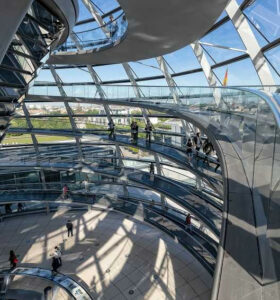 Most users, especially fabricators, of stainless steel will know stainless steel is an alloy of mainly iron and chrome that renders a group of materials with special properties over and above the fact that it is corrosion resistant. It is a durable family of steels that makes stainless steel suitable for virtually any application. However, we often find ourselves with a potential market or customer that resists stainless steel based on the initial purchase price of the material.
Most users, especially fabricators, of stainless steel will know stainless steel is an alloy of mainly iron and chrome that renders a group of materials with special properties over and above the fact that it is corrosion resistant. It is a durable family of steels that makes stainless steel suitable for virtually any application. However, we often find ourselves with a potential market or customer that resists stainless steel based on the initial purchase price of the material.
We cannot argue this fact, but we also accept that you have to invest more for lasting quality. We accept this fact when buying a house, a car, or a microwave. So why do we not accept this fact when doing material grade selection for a product or project?
Life Cycle Costing is crucial for sustainability
With this in mind and given that our footprint or impact on nature is a major current concern from a sustainability viewpoint, it might be worth investigating the true cost of stainless steel and some of the competitor metals over the life span of a project or product.
There is a technique to determine the true cost of a material over the complete life span of a project. This includes initial and all future costs related to the material over a given period. Determining the true cost of a project is important since we have an obligation to inform the end-user to as what the true cost of the proposed project will be.
We have the responsibility of being honest by disclosing the true financial commitment required from the end-user. This is important, because the life span of a project can be 100 years or even longer. The Canadian National Archives was designed with an expected lifespan of 500 years for example. This means that a small mistake in the initial choice of material can lead to expensive future costs. This will limit future options and will burden future generations. When we are responsible for sustainability our thought process should be focused on long-term solutions and the impact thereof.
How Life Cycle Costing impacts on sustainability
Life Cycle Costing (LCC) is the process of estimating how much money you will spend on an asset over the course of its useful life, not just the initial costs (the cost usually displayed on the quotation). LCC involves the tracing of costs and revenues of a product over several calendar periods throughout its life cycle.
LCC provides a method of assessing the costs that occur throughout a project’s lifespan, from raw material procurement, fabrication and construction, through use and maintenance, to end-of-life. In so doing, it provides a more robust insight into long-term costs and savings, compared to ROI-based calculations. The full cost of a project would include projections for items such as:
- future rates of interest and inflation
- designed or expected maintenance intervals and costs (both material and labour)
- desired service life
When assessing materials costs consideration should be given to long- and short-term factors such as:
- initial investment
- maintenance level and frequency
- downtime effects
- production losses, repair, replacement
- other operationally related costs such as manpower and energy consumption
The way that the calculation of the total LCC is formulated allows for all associated future costs to be calculated and expressed in present monetary values as a comparative benchmark. LCC uses the standard accounting principle of discounted cash flow. Costs of maintenance and associated downtime can outweigh the initial material costs. From a sustainability viewpoint it makes sense to calculate a full life cycle cost assessment.
LCC is the sum of acquisition cost, initial fabrication and installation costs, operational and maintenance costs, lost production due to down time, as well as replacement costs.
However, at the end of the project life, all material involved and still available can be retrieved for re-use or recycling. The value of this can therefore be subtracted from the total cost.
![]()
When using stainless steel, the end of life value becomes very important. In architectural installations it is estimated that around 92% of the original material will be available for recycling. In the case of coated carbon steel or galvanised installations, this figure is closer to values between 62% and 68%. Therefore, our industry can proudly say that more than 75% of all new stainless steel material comes from recycled sources.
Sassda’s LCC Toolbox:
Case Study 1: The Residential Fence

A middle income family needs to install a security fence with the following options:
1. A carbon steel construction to be powder coated
2. A 3CR12 construction to be powder coated
3. A 3CR12 construction with no coating and allowed to age naturally.
Some research into the detailed costing provided the following information.
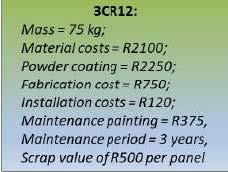
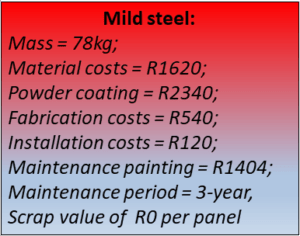
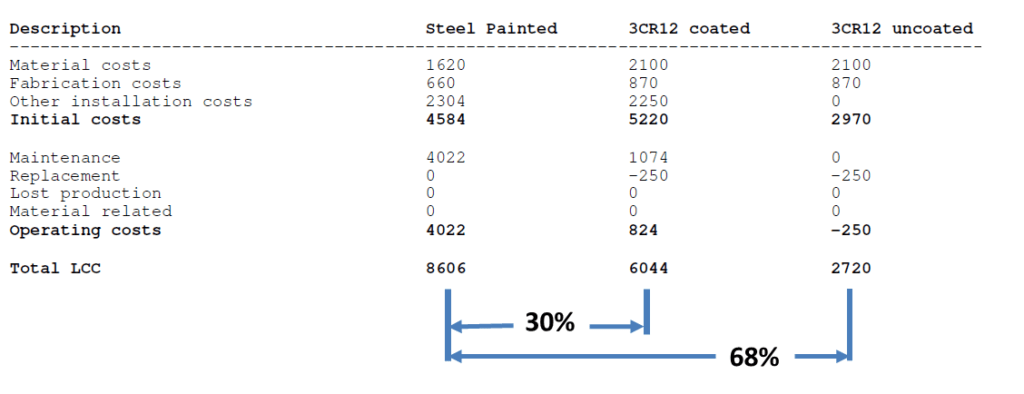
The Sassda application yields the results shown on the right with the highlights being that the uncoated 3CR12 version will be 68% lower in cost over the 15 years life span. Even if the 3CR12 is powder coated it would still be 30% less expensive than the coated carbon steel version.
Case Study 2: The Hydrometallurgical Walkway
 At a hydrometallurgical plant in Chile material must be selected for a walkway across very corrosive areas in the plant. Service life is 30 years, and three possible material types are being suggested for use:
At a hydrometallurgical plant in Chile material must be selected for a walkway across very corrosive areas in the plant. Service life is 30 years, and three possible material types are being suggested for use:
- Mild steel - Cheapest option, but the material is to be coated. This would require maintenance and repairing the protective surface every four years.
- 3CR12 - Unpainted. Every 15 years clean the surfaces with a high-pressure water.
- Lean Duplex - Expensive material, but with exceptional mechanical and corrosion characteristics. Therefore, the material can be gauged down, meaning less kilograms will be required giving reduced initial material cost.
Once again, the results favour the use of 3CR12 with the utility grade showing a 50% reduction in life span costs compared to the mild steel option. Even the Duplex grade with very high initial costs display a reduction of 23% compared to the mild steel option. Take note of the impact of end of life value in the graphic depiction of the cost analysis.
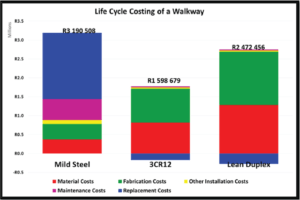
Case Study 3: The Repeat of the Eiffel Tower

Imagine you need to reconstruct the Eiffel Tower with a design life of 100 years. You have the following options: The potential grades would be a 3CR12, a duplex 2101, and mild steel like the material used on the existing tower. The mild steel will be painted with the current maintenance schedule. The 3CR12 will be allowed to form a surface patina. Therefore no maintenance will be required with 3CR12. The duplex material will always be maintained with a high-pressure waterjet every 20 years rendering the new tower shiny.
It comes as no surprise that the life cycle costs of the 3CR12 option is around 50% of the mild steel cost. The Lean Duplex version registers at around 77% of the mild steel cost.
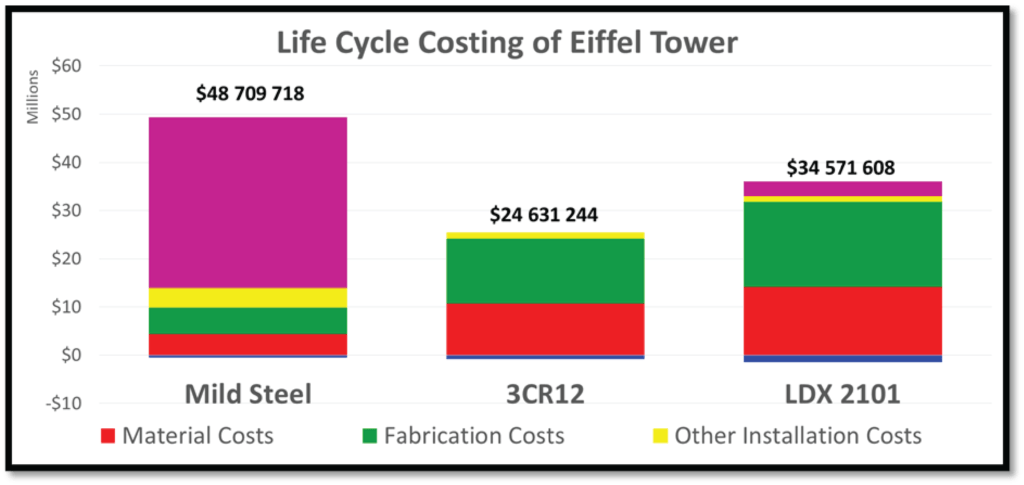
Case Study 4: Drinking Water solutions
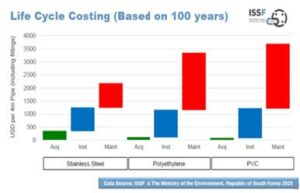 The first three case studies showed the cost efficiency of stainless steel, especially 3CR12, against competitor materials. However, stainless steel can even compete against specific plastics used in drink water applications with a cost advantage over the life span.
The first three case studies showed the cost efficiency of stainless steel, especially 3CR12, against competitor materials. However, stainless steel can even compete against specific plastics used in drink water applications with a cost advantage over the life span.
ISSF studies show an analysis of materials used in the pipework utilised in bringing water from the bulk supply to the end-user.
The life span used in this exercise is 100 years and based in the USD costs per 4m of installation pipework including fittings. The comparison was done between stainless steel, polyethylene, and PVC. The results speak for itself with stainless steel calculated to be at USD 2,172.00 per 4m length. The result for polyethylene stands at USD 3,340.00 and for PVC at USD 3,690.00 for the same length.
Stainless steel remains Simply Brilliant
In virtually all applications stainless steel shows substantial LCC life benefits.
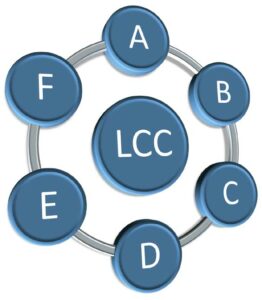 A - Acquisition Costs: Stainless steel contains more than 70% of recycled material.
A - Acquisition Costs: Stainless steel contains more than 70% of recycled material.
B - Fabrication and Installation: Stainless steel offers ease of fabrication and the mechanical properties allow for lighter structures.
C - Operational Costs: remains lower due to the durability of the material.
D - Lost production Costs: The durability of stainless steel also causes less down time and thus a reduction of related costs.
E - Maintenance Costs: Durability and less downtime leads to lower maintenance costs over and above the fact that stainless steel implies lower maintenance.
F – Recycling: The material complies with the standards for sustainability. Due to the high end of life material recovery rate, there is implied savings. Stainless steel is 100% recyclable.

